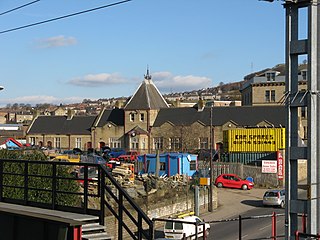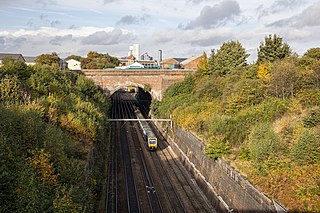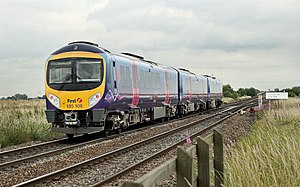
Selby railway station is a Grade II listed station which serves the town of Selby in North Yorkshire, England. The original terminus station was opened in 1834 for the Leeds and Selby Railway. The Hull and Selby Railway extended the line in 1840, and a new station was built, with the old station becoming a goods shed. The station was rebuilt in 1873 and 1891, the 1891 rebuilding being required due to the replacement of the swing bridge over the Ouse at the same time.

Cross Gates railway station serves Cross Gates, an area in Leeds, West Yorkshire, England. It lies on the Selby Line, operated by Northern 4.25 miles (7 km) east of Leeds railway station.

South Milford railway station serves the villages of South Milford and Sherburn in Elmet in North Yorkshire, England. It lies on the Selby Line 13 miles (21 km) east of Leeds.
The Leeds and Selby Railway was an early British railway company and first mainline railway within Yorkshire. It was opened in 1834.

The York and North Midland Railway (Y&NMR) was an English railway company that opened in 1839 connecting York with the Leeds and Selby Railway, and in 1840 extended this line to meet the North Midland Railway at Normanton near Leeds. Its first chairman was the railway financier George Hudson, who had been called the railway king.

Marsh Lane railway station was built as the Leeds terminus of the Leeds and Selby Railway. The combined passenger and goods station opened in 1834. During the construction of the extension of the Leeds and Selby Line into central Leeds in the 1860s the station was demolished, and replaced with a large goods station and a separate through passenger station.
Oldham Clegg Street railway station was the Oldham, Ashton-under-Lyne and Guide Bridge Junction Railway station that served the town of Oldham in northwest England, it had three associated goods stations.

Thongs Bridge railway station was the only intermediate stop on the railway line between Brockholes and Holmfirth, West Yorkshire, England. Opened in July 1850, the station was temporarily closed in 1865 due to the collapse of Mytholmbridge Viaduct. The station closed to passengers permanently in 1959, closing completely in 1965.

St Dunstans railway station is a closed station in the city of Bradford, West Yorkshire, England. The station was the location of a three-way junction with platforms on two of the lines.

Bamfurlong railway station served the village of Bamfurlong part of Abram, to the south of Wigan.

West Rounton Gates railway station, was a railway station between Welbury and Picton railway stations on the Leeds Northern Railway in the Hambleton District of North Yorkshire, England. The station was opened in 1864, but it was served by trains on Wednesdays only for the market day in Stockton-on-Tees.

The Shipley Great Northern Railway branch line was a railway line that ran east, south and then westwards from Shipley to Bradford in West Yorkshire. The route was opened in 1874 to goods traffic and then to passengers in 1875 by the Great Northern Railway (GNR) and looped around the eastern edge of Bradford. The GNR arrived after other railways had been established in the West Yorkshire area and many of their lines were heavily reliant on tunnels and grand viaducts, the Shipley and Windhill line being an exception to this, although it did have some steep gradients. The branch extended for 8.5 miles (13.7 km) between the two termini of Shipley Windhill and Bradford Exchange. The route as built from Laisterdyke to Shipley was actually only 6.5 miles (10.5 km) as the initial section from Bradford Exchange to Laisterdyke was already in existence as part of the Great Northern Railway's line to Leeds.

The York and Doncaster branch was a railway line that opened in 1871 connecting Doncaster with York via Selby in Yorkshire, England. This line later became part of the East Coast Main Line (ECML) and was the route that express trains took between London King's Cross, the north of England and Scotland. It was opened by the North Eastern Railway (NER) between York and Shaftholme Junction, some 4.5 miles (7.2 km) north of Doncaster railway station. Between its opening in 1871 and the grouping in 1923, the line was used by both the NER, and the Great Northern Railway (GNR). All of the intermediate local stations that had opened with the line in 1871 closed down in the 1950s and 1960s leaving just Selby open between the town of Doncaster and the city of York.

Thwaites railway station was a railway station located just east of Keighley, West Riding of Yorkshire, on the Midland Railway line through the Aire Valley between Keighley and Shipley. It opened to traffic in 1892 and closed 17 years later in 1909 due to poor patronage.
Trenholme Bar railway station was a railway station built to serve the hamlet of Trenholme Bar in North Yorkshire, England. The station was on the North Yorkshire and Cleveland's railway line between Picton and Stokesley, which opened in 1857. The line was extended progressively until it met the Whitby & Pickering Railway at Grosmont. Trenholme Bar station was closed in 1954 to passengers and four years later to goods. The station was located 9 miles (14 km) south of Stockton, and 10 miles (16 km) west of Battersby railway station.

Richmond Hill Tunnel is a railway tunnel to the east of Leeds city centre, in West Yorkshire, England. The tunnel is known to be the first in the world specifically designed to carry passengers to be worked by steam trains rather than a stationary engine. One of the innovative methods employed to reassure passengers going through the lightless tunnel, was to place copper sheets underneath the air shafts which were intended to reflect the light around the tunnel. The original Richmond Hill Tunnel was 700 yards (640 m) long, but in 1894, it was widened into a cutting with a shorter tunnel, which is the existing structure in use today. The present Richmond Hill Tunnel is 118 yards (108 m) long, and is part of the longer Marsh Lane Cutting, which connects the eastward entrance and exit into Leeds railway station to the lines going towards Selby and York.

Monk Fryston railway station was a railway station serving the village of Monk Fryston in North Yorkshire, England. Previously, Milford Junction and Old Junction served as an interchange between the Leeds and Selby and the York and North Midland Lines, however when they closed in the early 1900s, Monk Fryston was opened to cover for this loss of interchange. Though the station had four tracks through it, it only ever had two platforms. The station closed to passengers in 1959, and then completely in 1964.

Meltham railway station was the terminus of the Meltham branch line from Lockwood (Huddersfield) to Meltham, in the West Riding of Yorkshire, England. Traffic partially started in 1868, but became regular in July 1869. The station, and line, were opened by the Lancashire & Yorkshire Railway (L&YR), later becoming part of the London Midland Scottish Railway. The station closed to passengers in 1949, though the branch remained open to freight until the 1960s. The railway station site is now the location of a supermarket.
Gascoigne Wood Junction railway station was a railway station near Sherburn-in-Elmet in North Yorkshire, England. It was originally opened as a junction station, enabling transfers for passengers between trains. It was later a private halt station for the staff who worked at the Gascoigne Wood marshalling yard. It opened in 1839, and was closed, renamed and re-opened several times before closing completely in 1959. The station was 14 miles (23 km) from Leeds New Station, and 6 miles (9.7 km) from Selby.

Woodkirk railway station was a Great Northern Railway (GNR) station on the Batley to Beeston line, which connected Batley to Leeds Central, in West Yorkshire, England. The station opened in July 1890 and was closed in September 1939 to passengers, but the line stayed open until 1964. The station was 1.75 miles (2.82 km) north of Batley railway station, and 6.75 miles (10.86 km) south of Leeds Central railway station.

















